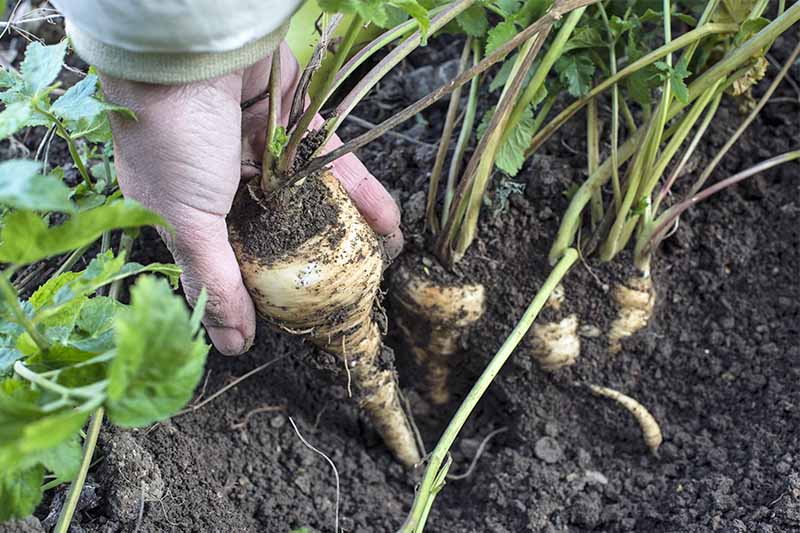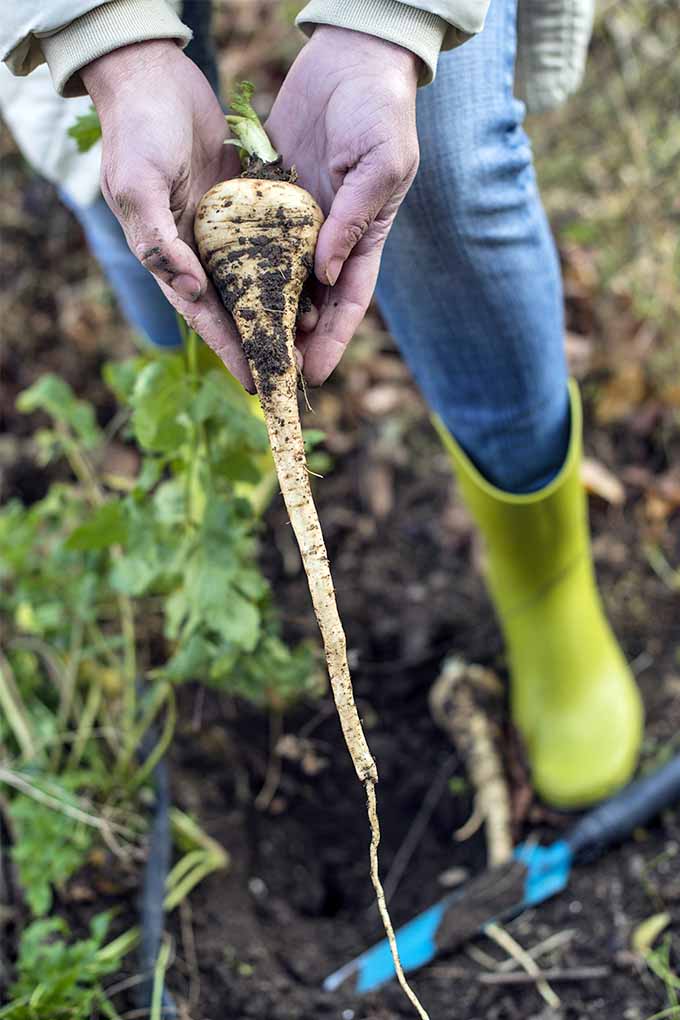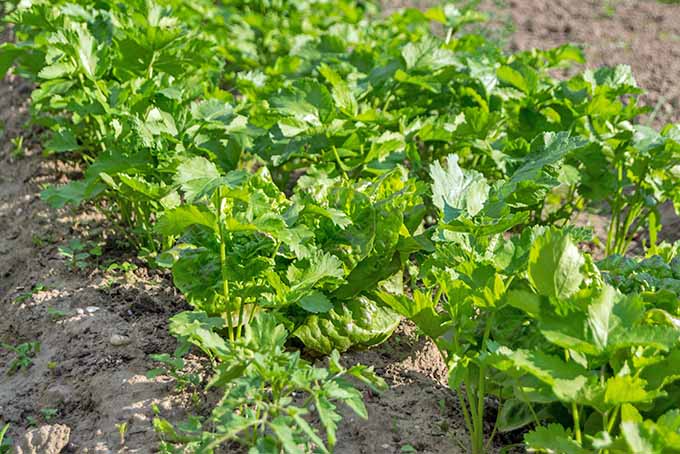The parsnip is an underappreciated root vegetable that deserves a place in every vegetable garden. But many gardeners struggle to identify parsnip plants accurately, especially when they first emerge.
In this complete guide, you’ll learn everything you need to positively identify parsnip plants at every stage of growth.
A Brief History of Parsnips
Parsnips are native to Eurasia and were first cultivated in ancient times, especially by the Romans. Their sweet flavor made them useful as a sugar substitute.
After the potato became more readily available in the 1800s, parsnips fell out of favor and became more of a novelty crop. But lately, they are staging a modest comeback thanks to the rising interest in heirloom vegetables.
What Does a Parsnip Plant Look Like?
Here are the key traits that identify parsnips at every stage of growth:
Seedlings
- Emerges 2-4 weeks after planting
- First leaves are oval with slightly toothed edges
Leaves
- Alternate, pinnately compound leaves with 3-7 leaflets
- Leaflets have toothed edges and pointed tips
- Leaves grow up to 16 inches long
- Yellowish-green color with hairy undersides
- Strong, characteristic odor when crushed
Stems
- Erect, grooved, hollow stems up to 5 feet tall
- Few small leaves along upper portion of stem
- Stem thickens and becomes woody in second year
Flowers
- Flat-topped clusters of small yellow flowers called umbels
- Flowers bloom in second year between June and August
- Umbels can be 4-8 inches wide with 20-100 flowers
Roots
- Creamy white, tapered taproots
- Can reach 18 inches long and 2-3 inches wide at crown
- Turn beige and wrinkled as they mature
- Flesh is creamy white with slight greenish tinge
How Parsnips Are Different From Lookalikes
Parsnips resemble some other common vegetables. Here’s how to tell them apart:
-
Carrots – Parsnip roots are paler and leaves are lighter green.
-
Salsify – AKA oyster plant, Has purple flowers and narrower leaves,
-
Parsley Root – Does not have biennial growth habit of parsnips.
-
Wild Parsnip – Weedy relative with thinner roots and pale yellow flowers. Causes rashes.
Ideal Growing Conditions for Parsnips
To grow healthy parsnip plants, provide:
-
Sun – Full sun (at least 6 hours)
-
Soil – Loose, stone-free soil with a pH of 6.0-7.0
-
Temperature – Germination at 50-85°F. Cool weather for growth.
-
Water – Consistent moisture, especially when seeds are sprouting
-
Fertilizer – Very little needed in fertile soil. Avoid excess nitrogen.
Common Pests and Diseases
Be on the lookout for these potential parsnip problems:
-
Carrot rust flies – Feed on roots causing tunnels and rot
-
Aphids – Suck plant sap and cause distortion
-
Canker – Fungal disease that rots crowns
-
Root rot – Caused by various soil-borne fungi
Ready to Grow Parsnips?
Now that you know how to identify parsnip plants, why not grow some in your garden? Remember they take a while to sprout and need cool conditions. But their sweet flavor makes them worth the effort.
When planting, choose fresh seeds and sow them later in spring once the soil warms up. Keep plants consistently watered and weed-free. And be patient waiting for those tasty roots to size up!

What You Need to Know About Parsnip Burn
I’m thankful I can’t speak from experience on this, but it definitely is worth mentioning.
There have been a number of stories of people who, given the right circumstances, have ended up with burnt, blistering skin, due to harvesting common garden crops! And while it’s not crazy common, it’s helpful to be aware of so you can hopefully avoid it yourself.
Usually the burning, itching rash, called phytophotodermatitis, is associated with wild parsnip, which is a pretty common roadside weed. However, garden parsnip, just a domesticated variety of wild parsnip, as well as carrots and celery (all related, by the way), have been reported to do the same.

Moisture and sunshine seem to be the key factors for the reaction to occur.
Chemicals in the sap of leaves and stems first need to make contact with the skin. Moisture, such as that from the morning dew or a sweaty gardener, exasperates the spread and absorption of the problem chemicals. And then the UV light from the hot sun comes in and triggers the reaction.
So, simply harvesting parsnips or carrots doesn’t mean you’ll have a reaction. It’s the combination of exposure, moisture, and sun that dooms you.
However, awareness is key, since the red, burnt, blistery skin usually doesn’t occur until days after exposure.
If you’re concerned, harvest suspected crops early, before the heat sets in, and also avoid harvesting them if they’re wet. And to go a step further, long sleeves, pants, and gloves will do the trick.
Parsnips can be harvested whenever their leaves start dying back or they reach a usable diameter, around 3/4 of an inch.
However, if you’re patient and harvest in the fall after a hard frost or two, you’ll be rewarded with sweeter roots.

Although they require a long growing season, parsnips provide a great source of homegrown food when most other garden produce has already been devoured. And as long as the soil isn’t frozen, you can continue harvesting throughout the fall and into winter.
Plants can even be left to overwinter in the ground. Just cover them with mulch and harvest the roots when the soil is thawed in late winter or early spring.

If you choose this method, be sure to harvest roots before they begin pushing new growth the following spring. Once new leaves begin to emerge, roots become more fibrous and tough.
As the roots are long and can easily break, take care to loosen the plants appropriately before harvesting.
Slow to Start, Strong to Finish
Don’t be too quick to relax once seeds germinate. Parsnips take a few weeks to put on significant growth, and during that time, weeds can out compete them.
Keep plants weed free during those first few weeks, and beyond that, you’re in the home stretch. As the leaves fill in and shade the surrounding soil, weeds become less of an issue.
Once plants start taking off, you can rest easy. Care for parsnips from this point on is very similar to that of growing carrots.
In general, adequate soil moisture throughout the summer is key to growing healthy root crops. It is especially important to water thoroughly during dry spells.

Roots go where there’s water. So, watering deeply encourages strong root growth. A good soaking is best achieved slowly, with soaker hoses or drip irrigation.
And if you have a habit of passing over your garden too quickly with the hose, installing a simple irrigation system is sure benefit your garden – especially your root crops.
Frequent but shallow watering encourages shallow, weak roots, and plants that are even more susceptible to drought.
Ensure that the soil is well draining, since standing water can easily cause roots to rot.
Although relatively pest and disease free, there are a few issues to keep an eye out for as you watch your parsnips grow:
Particularly those of swallowtail butterflies like to munch on the leaves.

Just pick them off if you see them.
These sap-sucking little insects can also pose an issue. My preferred method to control aphids is to simply blast them with the hose.
These flies – and more specifically their maggot larvae – feed on the roots of many root crops.
Prevention is best here. Try companion planting with chives, which are known to repel carrot flies.
Rotting of the root that starts at the top can result from drought or damage to the crown.
With all these things considered, you’re on your way to a successful harvest!
How to Grow Parsnips
FAQ
What does a wild parsnip plant look like?
Wild parsnip bolts its second year and can grow up to 6 feet tall. Seedlings have taproots and can grow in thick grass. Leaves are pinnately compound with pairs of egg-shaped leaflets with saw-toothed edges. Thick, long, white taproot resembles cultivated parsnips.
What do parsnip roots look like?
The ability of wild parsnip to store energy during the first year is critical for reproductive success in the plant’s second and final year. Roots are cream colored, and often tapered like a carrot.
Are wild parsnips safe to eat?
While wild Parsnip roots are edible, the plant produces a compound in its leaves, stems, flowers, and fruits that causes intense, localized burning, rash, …Jul 5, 2019
How do you take care of a parsnip plant?
Parsnips need little ongoing care, apart from weeding when young and watering in dry spells. The roots are ready to harvest from autumn onwards, although it’s best to delay until after the first hard frost for the sweetest flavour.
